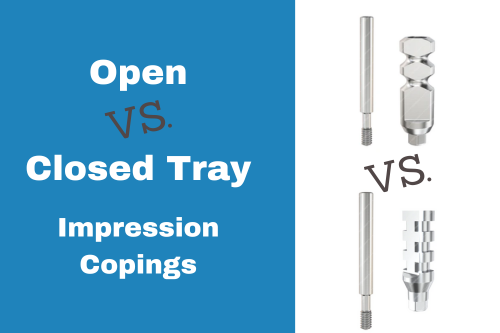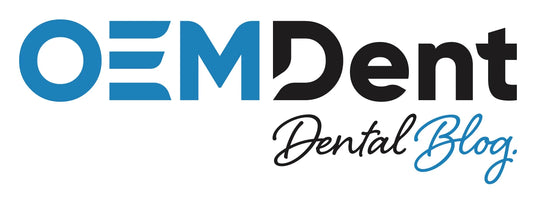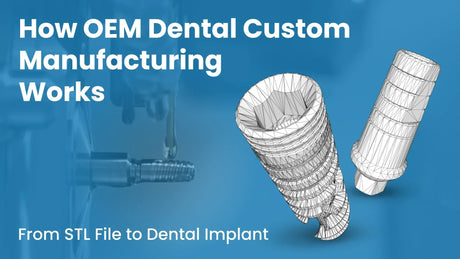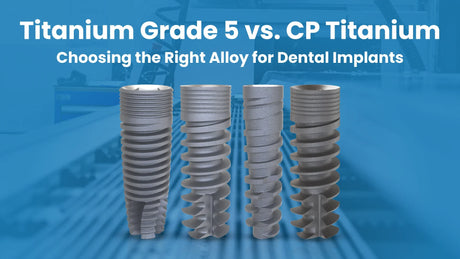

Understanding Impression Copings - The Key to Perfect Implant Restorations
When placing dental implants, accuracy is everything. The difference between a seamless, natural looking restoration and one that doesn’t fit properly often comes down to a single step - the impression. A perfect impression ensures that the final prosthesis aligns exactly with the implant.
And the key to a perfect impression? Impression Copings.
These small but powerful components play a huge role in making sure the position of the implant in the patient’s mouth is precisely transferred to the dental lab. Without them, the lab technician wouldn’t know exactly where to place the crown, bridge, or denture. The result? A restoration that doesn’t fit, isn’t comfortable, or even worse - fails entirely.
Let’s break down what impression copings are, how they work, and why choosing the right one - open tray or close tray - makes all the difference.
What Are Impression Copings?
Impression copings are temporary components that attach to the dental implant to help capture its exact position, angle, and depth. Once the impression is taken, the coping allows this data to be transferred to the lab, where a model of the patient's mouth is created.
Think of impression copings as connectors between the patient’s mouth and the lab. They ensure that the final restoration is positioned precisely where the implant was placed. Even a small inaccuracy can cause serious issues, such as an ill fitting crown, bite problems, or even implant failure.
There are two main types of impression copings:
Both work, but they’re used in different situations depending on accuracy needs, implant position, and personal preference.
Open Tray Impression Copings - Maximum Accuracy
Open tray impressions, also known as pick up impressions, are widely considered the gold standard for accuracy in implant restorations.
How Open Tray Impression Copings Work:
-
The impression coping is firmly screwed into the implant inside the patient’s mouth.
-
A custom tray with an open hole is placed over the coping.
-
Impression material is added, capturing the position of the implant.
-
Once the material sets, the dentist unscrews the coping from the implant but leaves it inside the impression.
-
The impression is then sent to the lab, with the coping locked inside, ensuring an exact replica of the implant position.
When to Use Open Tray Impression Copings:
-
When working with multiple implants
-
When implants are deep or angled
-
When maximum accuracy is required for a perfect fit
Advantages of Open Tray Impressions:
-
Highest level of accuracy - Ideal for complex cases where even slight errors could affect the fit.
-
No risk of misalignment - Since the coping stays inside the impression, the lab gets a 100 percent accurate position of the implant.
-
Best for full arch restorations - When working with multiple implants, open tray impressions prevent errors caused by repositioning.
Disadvantages of Open Tray Impressions:
-
Requires a custom tray - Standard trays don’t have holes, so a customized open tray must be used.
-
Takes more time - Extra steps are needed compared to close tray impressions.
If absolute accuracy is a must, open tray impressions are the way to go. But what if you’re looking for a simpler, quicker alternative? That’s where close tray impression copings come in.
Close Tray Impression Copings - Simple and Efficient
Close tray impressions, also called transfer impressions, are often used in cases where speed and convenience are more important than absolute precision.
How Close Tray Impression Copings Work:
-
The impression coping is secured onto the implant in the patient’s mouth.
-
A regular closed tray (no holes) is filled with impression material and placed over the coping.
-
Once the material sets, the tray is removed, but the coping stays in the mouth.
-
The coping is then unscrewed and attached to an implant analog, which is placed into the impression before being sent to the lab.
When to Use Close Tray Impression Copings:
-
When taking single implant impressions
-
When working with straight, shallow implants
-
When speed and simplicity are a priority
Advantages of Close Tray Impressions:
-
Faster and easier - Less technique sensitive, making it a great option for general practitioners.
-
No need for a custom tray - Works with standard impression trays.
-
More comfortable for patients - No need for a tray with a hole, which some patients find uncomfortable.
Disadvantages of Close Tray Impressions:
-
Slightly less accurate - If the coping is not perfectly repositioned in the impression, it can lead to small errors.
-
Not ideal for multiple implants - Since each coping must be placed back into the impression manually, there’s a risk of misalignment.
-
Risk of distortion - If the impression material is pulled or stretched during removal, it can affect the final restoration.
For simple, single unit cases, close tray impression copings are a great choice. They save time and make the impression taking process easier. But when absolute precision is needed, open tray impressions are the better option.
Which One Should You Use?
The decision between open tray vs. close tray impression copings depends on the case:
-
If you want maximum accuracy and are working with multiple implants, choose open tray impression copings.
-
If you need a quick and simple impression for a single implant, go with close tray impression copings.
Both techniques have their place in implant dentistry. The key is knowing when to use each one to achieve the best results.
Pro Tips for Perfect Impressions
-
Always check that the impression coping is fully seated before taking the impression. Even a slight gap can lead to an inaccurate final restoration.
-
Use high quality impression materials that provide excellent detail and dimensional stability.
-
For open tray impressions, make sure the coping is unscrewed before removing the tray. This prevents distortion.
-
For close tray impressions, carefully reposition the coping inside the impression. Any misalignment can affect the fit of the final restoration.
-
Communicate clearly with your lab. Make sure they know whether you used an open tray or close tray technique so they can process the model correctly.
The Rise of Digital Dentistry - How Body Scans Are Changing Implant Impressions
We almost forgot to talk about body scans.
You can find them in PEEK material and titanium, and they are becoming more common in implant dentistry. As technology improves, more dentists are using digital tools to take impressions instead of traditional methods.
While impression copings are still very effective, many clinics are now switching to intraoral scanning and digital impressions to get faster and more precise results.
Body scans allow dentists to capture the exact position of an implant without using physical impression materials. This reduces mistakes and makes the process easier for both dentists and patients. PEEK body scans are lightweight and radiolucent, making them easy to work with, while titanium body scans offer strength and accuracy.
Using digital scans means fewer errors, fewer adjustments, and a more comfortable experience for patients. Traditional impression copings are still a great option, but body scans and digital workflows are quickly becoming the future of implant dentistry.
Final Thoughts
Impression copings may seem like a small part of the implant process, but they play a major role in the success of the final restoration. Whether you choose an open tray or close tray technique, using the right impression coping ensures that the lab gets the most accurate information possible.
At OEMDent, we offer a wide range of high quality impression copings to help you achieve perfect implant restorations. Check out our selection today and take your implant cases to the next level.
Have questions about impression copings? We’re here to help.

OEMDent.com offers uncompromised quality, cost-effective dental implants & prosthetics compatible with leading implant systems. We go beyond manufacturing, offering OEM & Private Label services to meet your dental needs.






